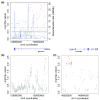Population sequencing of two endocannabinoid metabolic genes identifies rare and common regulatory variants associated with extreme obesity and metabolite level
- PMID: 21118518
- PMCID: PMC3156957
- DOI: 10.1186/gb-2010-11-11-r118
Population sequencing of two endocannabinoid metabolic genes identifies rare and common regulatory variants associated with extreme obesity and metabolite level
Abstract
Background: Targeted re-sequencing of candidate genes in individuals at the extremes of a quantitative phenotype distribution is a method of choice to gain information on the contribution of rare variants to disease susceptibility. The endocannabinoid system mediates signaling in the brain and peripheral tissues involved in the regulation of energy balance, is highly active in obese patients, and represents a strong candidate pathway to examine for genetic association with body mass index (BMI).
Results: We sequenced two intervals (covering 188 kb) encoding the endocannabinoid metabolic enzymes fatty-acid amide hydrolase (FAAH) and monoglyceride lipase (MGLL) in 147 normal controls and 142 extremely obese cases. After applying quality filters, we called 1,393 high quality single nucleotide variants, 55% of which are rare, and 143 indels. Using single marker tests and collapsed marker tests, we identified four intervals associated with BMI: the FAAH promoter, the MGLL promoter, MGLL intron 2, and MGLL intron 3. Two of these intervals are composed of rare variants and the majority of the associated variants are located in promoter sequences or in predicted transcriptional enhancers, suggesting a regulatory role. The set of rare variants in the FAAH promoter associated with BMI is also associated with increased level of FAAH substrate anandamide, further implicating a functional role in obesity.
Conclusions: Our study, which is one of the first reports of a sequence-based association study using next-generation sequencing of candidate genes, provides insights into study design and analysis approaches and demonstrates the importance of examining regulatory elements rather than exclusively focusing on exon sequences.
© 2010 Harismendy et al.; licensee BioMed Central Ltd.
Figures





References
-
- Frazer KA, Ballinger DG, Cox DR, Hinds DA, Stuve LL, Gibbs RA, Belmont JW, Boudreau A, Hardenbol P, Leal SM, Pasternak S, Wheeler DA, Willis TD, Yu F, Yang H, Zeng C, Gao Y, Hu H, Hu W, Li C, Lin W, Liu S, Pan H, Tang X, Wang J, Wang W, Yu J, Zhang B, Zhang Q, Zhao H. et al.A second generation human haplotype map of over 3.1 million SNPs. Nature. 2007;449:851–861. doi: 10.1038/nature06258. - DOI - PMC - PubMed
-
- Manolio TA, Collins FS, Cox NJ, Goldstein DB, Hindorff LA, Hunter DJ, McCarthy MI, Ramos EM, Cardon LR, Chakravarti A, Cho JH, Guttmacher AE, Kong A, Kruglyak L, Mardis E, Rotimi CN, Slatkin M, Valle D, Whittemore AS, Boehnke M, Clark AG, Eichler EE, Gibson G, Haines JL, Mackay TF, McCarroll SA, Visscher PM. Finding the missing heritability of complex diseases. Nature. 2009;461:747–753. doi: 10.1038/nature08494. - DOI - PMC - PubMed

